Thylacine
The thylacine (/ˈθaɪləsiːn/ THY-lə-seen,[13] or /ˈθaɪləsaɪn/ THY-lə-syne,[14] also /ˈθaɪləsɪn/;[15] from Ancient Greek θύλακος thúlakos, "pouch, sack" + Latin -inus "-ine") (Thylacinus cynocephalus), now extinct, is one of the largest known carnivorous marsupials, evolving about 4 million years ago.[upper-alpha 1] The last known live animal was captured in 1933 in Tasmania. It is commonly known as the Tasmanian tiger because of its striped lower back, or the Tasmanian wolf because of its canid-like characteristics. It was native to Tasmania, New Guinea, and the Australian mainland.
| Thylacine[1] | |
|---|---|
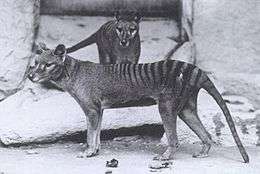 | |
| Thylacines in the National Zoo in Washington, D.C., c. 1906 | |
| Scientific classification | |
| Kingdom: | Animalia |
| Phylum: | Chordata |
| Class: | Mammalia |
| Infraclass: | Marsupialia |
| Order: | Dasyuromorphia |
| Family: | †Thylacinidae |
| Genus: | †Thylacinus |
| Species: | †T. cynocephalus |
| Binomial name | |
| †Thylacinus cynocephalus (Harris, 1808)[4] | |
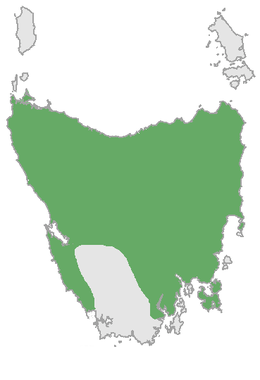 | |
| Historic Thylacine range in Tasmania (in green)[5] | |
| Synonyms | |
|
List
| |
The thylacine was relatively shy and nocturnal, with the general appearance of a medium-to-large-size dog, except for its stiff tail and abdominal pouch similar to a kangaroo's, and dark transverse stripes that radiated from the top of its back, reminiscent of a tiger. The thylacine was a formidable apex predator,[5] though exactly how large its prey animals were is disputed. Because of convergent evolution it displayed a form and adaptations similar to the tiger and wolf of the Northern Hemisphere, even though not related. Its closest living relative is either the Tasmanian devil or the numbat. The thylacine was one of only two marsupials to have a pouch in both sexes: the other is the water opossum. The pouch of the male thylacine served as a protective sheath covering the external reproductive organs.
The thylacine had become extinct on the Australian mainland before British settlement of the continent, but it survived on the island of Tasmania along with several other endemic species, including the Tasmanian devil. Intensive hunting encouraged by bounties is generally blamed for its extinction, but other contributing factors may have been disease, the introduction of dogs, and human encroachment into its habitat.
Taxonomic and evolutionary history
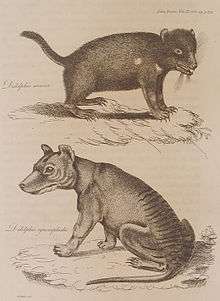
Numerous examples of thylacine engravings and rock art have been found dating back to at least 1000 BC.[16] Petroglyph images of the thylacine can be found at the Dampier Rock Art Precinct on the Burrup Peninsula in Western Australia.
By the time the first European explorers arrived, the animal was already extinct in mainland Australia and rare in Tasmania. Europeans may have encountered it in Tasmania as far back as 1642 when Abel Tasman first arrived in Tasmania. His shore party reported seeing the footprints of "wild beasts having claws like a Tyger".[17] Marc-Joseph Marion du Fresne, arriving with the Mascarin in 1772, reported seeing a "tiger cat".[18] Positive identification of the thylacine as the animal encountered cannot be made from this report since the tiger quoll (Dasyurus maculatus) is similarly described.
The first definitive encounter was by French explorers on 13 May 1792, as noted by the naturalist Jacques Labillardière, in his journal from the expedition led by D'Entrecasteaux. In 1805 William Paterson, the Lieutenant Governor of Tasmania, sent a detailed description for publication in the Sydney Gazette.[19] He also sent a description of the Thylacine in a letter to Joseph Banks dated 30 March 1805.[20]
The first detailed scientific description was made by Tasmania's Deputy Surveyor-General, George Harris in 1808, five years after first European settlement of the island.[4][21][22] Harris originally placed the thylacine in the genus Didelphis, which had been created by Linnaeus for the American opossums, describing it as Didelphis cynocephala, the "dog-headed opossum". Recognition that the Australian marsupials were fundamentally different from the known mammal genera led to the establishment of the modern classification scheme, and in 1796, Geoffroy Saint-Hilaire created the genus Dasyurus where he placed the thylacine in 1810. To resolve the mixture of Greek and Latin nomenclature, the species name was altered to cynocephalus. In 1824, it was separated out into its own genus, Thylacinus, by Temminck.[23] The common name derives directly from the genus name, originally from the Greek θύλακος (thýlakos), meaning "pouch" or "sack".[24][a]
Evolution
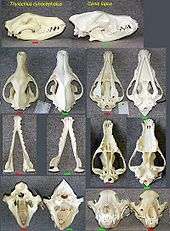
The modern thylacine probably appeared about 2 million years ago, during the Early Pleistocene: Pliocene-aged specimens from the Pliocene-aged Chinchilla Fauna, described as Thylacinus rostralis by Charles De Vis in 1894, is now attributed to this species.[26][27] Species of the family Thylacinidae date back to the beginning of the Miocene; since the early 1990s, at least seven fossil species have been uncovered at Riversleigh, part of Lawn Hill National Park in northwest Queensland.[28][29] Dickson's thylacine (Nimbacinus dicksoni) is the oldest of the seven discovered fossil species, dating back to 23 million years ago. This thylacinid was much smaller than its more recent relatives.[30] The largest species, the powerful thylacine (Thylacinus potens) which grew to the size of a wolf, was the only species to survive into the late Miocene.[31] In late Pleistocene and early Holocene times, the modern thylacine was widespread (although never numerous) throughout Australia and New Guinea.[32]
An example of convergent evolution, the thylacine showed many similarities to the members of the dog family, Canidae, of the Northern Hemisphere: sharp teeth, powerful jaws, raised heels and the same general body form. Since the thylacine filled the same ecological niche in Australia as the dog family did elsewhere, it developed many of the same features. Despite this, as a marsupial it is unrelated to any of the Northern Hemisphere placental mammal predators.[33]
They are easy to tell from a true dog because of the stripes on the back but the skeleton is harder to distinguish. Zoology students at Oxford had to identify 100 zoological specimens as part of the final exam. Word soon got around that, if ever a 'dog' skull was given, it was safe to identify it as Thylacinus on the grounds that anything as obvious as a dog skull had to be a catch. Then one year the examiners, to their credit, double bluffed and put in a real dog skull. The easiest way to tell the difference is by the two prominent holes in the palate bone, which are characteristic of marsupials generally.[34]
— Richard Dawkins, The Ancestor's Tale
The thylacine is a basal member of the Dasyuromorphia along with numbats, dunnarts, wambengers, and quolls. The cladogram follows:[35]
| Dasyuromorphia |
| ||||||||||||||||||||||||
Description
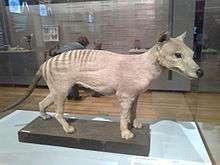
The only recorded species of Thylacinus, a genus that resembles the dogs and foxes of the family Canidae, the animal was a predatory marsupial that existed on mainland Australia during the Holocene epoch and observed by Europeans on the island of Tasmania; the species is known as the Tasmanian tiger for the striped markings of the pelage.
Descriptions of the thylacine come from preserved specimens, fossil records, skins and skeletal remains, and black and white photographs and film of the animal both in captivity and from the field. The thylacine resembled a large, short-haired dog with a stiff tail which smoothly extended from the body in a way similar to that of a kangaroo.[33]
The mature thylacine ranged from 100 to 130 cm (39 to 51 in) long, plus a tail of around 50 to 65 cm (20 to 26 in).[36] Adults stood about 60 cm (24 in) at the shoulder and weighed 20 to 30 kg (40 to 70 lb).[36] There was slight sexual dimorphism with the males being larger than females on average.[37]
Thylacines, uniquely for marsupials, have largely cartilaginous epipubic bones with a highly reduced osseous element.[38][39] This has been once considered a synapomorphy with sparassodonts,[40] though it is now thought that both groups reduced their epipubics independently.
Its yellow-brown coat featured 15 to 20 distinctive dark stripes across its back, rump and the base of its tail,[41] which earned the animal the nickname "tiger". The stripes were more pronounced in younger specimens, fading as the animal got older.[41] One of the stripes extended down the outside of the rear thigh. Its body hair was dense and soft, up to 15 mm (0.6 in) in length. Colouration varied from light fawn to a dark brown; the belly was cream-coloured.[42]
Its rounded, erect ears were about 8 cm (3.1 in) long and covered with short fur.[43]
The early scientific studies suggested it possessed an acute sense of smell which enabled it to track prey,[44] but analysis of its brain structure revealed that its olfactory bulbs were not well developed. It is likely to have relied on sight and sound when hunting instead.[41]
The thylacine was able to open its jaws to an unusual extent: up to 80 degrees.[45] This capability can be seen in part in David Fleay's short black-and-white film sequence of a captive thylacine from 1933. The jaws were muscular, and had 46 teeth, but studies show the Thylacine jaw was too weak to kill sheep.[43][46][47]
The tail vertebrae were fused to a degree, with resulting restriction of full tail movement. Fusion may have occurred as the animal reached full maturity. The tail tapered towards the tip. In juveniles, the tip of the tail had a ridge.[48]
The female thylacine had a pouch with four teats, but unlike many other marsupials, the pouch opened to the rear of its body. Males had a scrotal pouch, unique amongst the Australian marsupials,[49] into which they could withdraw their scrotal sac for protection.[41]
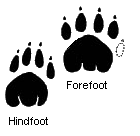
Thylacine footprints could be distinguished from other native or introduced animals; unlike foxes, cats, dogs, wombats or Tasmanian devils, thylacines had a very large rear pad and four obvious front pads, arranged in almost a straight line.[44] The hindfeet were similar to the forefeet but had four digits rather than five. Their claws were non-retractable.[41]
More detail can be seen in a cast taken from a freshly dead thylacine. The cast shows the plantar pad in more detail and shows that the plantar pad is tri-lobal in that it exhibits three distinctive lobes. It is a single plantar pad divided by three deep grooves. The distinctive plantar pad shape along with the asymmetrical nature of the foot makes it quite different from animals such as dogs or foxes. This cast dates back to the early 1930s and is part of the Museum of Victoria's thylacine collection.[50]
Some observers described it having a strong and distinctive smell, others described a faint, clean, animal odour, and some no odour at all. It is possible that the thylacine, like its relative, the Tasmanian devil, gave off an odour when agitated.[51]
The thylacine was noted as having a stiff and somewhat awkward gait, making it unable to run at high speed. It could also perform a bipedal hop, in a fashion similar to a kangaroo—demonstrated at various times by captive specimens.[41] Guiler speculates that this was used as an accelerated form of motion when the animal became alarmed.[42] The animal was also able to balance on its hind legs and stand upright for brief periods.[52]
Observers of the animal in the wild and in captivity noted that it would growl and hiss when agitated, often accompanied by a threat-yawn. During hunting it would emit a series of rapidly repeated guttural cough-like barks (described as "yip-yap", "cay-yip" or "hop-hop-hop"), probably for communication between the family pack members. It also had a long whining cry, probably for identification at distance, and a low snuffling noise used for communication between family members.[53]
Distribution and habitat
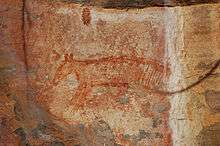
The thylacine probably preferred the dry eucalyptus forests, wetlands, and grasslands of mainland Australia.[44] Indigenous Australian rock paintings indicate that the thylacine lived throughout mainland Australia and New Guinea. Proof of the animal's existence in mainland Australia came from a desiccated carcass that was discovered in a cave in the Nullarbor Plain in Western Australia in 1990; carbon dating revealed it to be around 3,300 years old.[54] Recently examined fossilised footprints also suggest historical distribution of the species on Kangaroo Island.[55]
In Tasmania it preferred the woodlands of the midlands and coastal heath, which eventually became the primary focus of British settlers seeking grazing land for their livestock.[56] The striped pattern may have provided camouflage in woodland conditions,[41] but it may have also served for identification purposes.[57] The animal had a typical home range of between 40 and 80 km2 (15 and 31 sq mi).[42] It appears to have kept to its home range without being territorial; groups too large to be a family unit were sometimes observed together.[58]
Ecology and behaviour
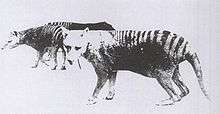

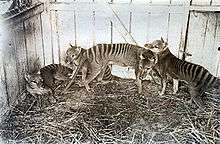
Little is known about the behaviour of the thylacine. A few observations were made of the animal in captivity, but only limited, anecdotal evidence exists of the animal's behaviour in the wild. Most observations were made during the day whereas the thylacine was naturally nocturnal. Those observations, made in the twentieth century, may have been atypical as they were of a species already under the stresses that would soon lead to its extinction. Some behavioural characteristics have been extrapolated from the behaviour of its close relative, the Tasmanian devil.
The thylacine was a nocturnal and crepuscular hunter, spending the daylight hours in small caves or hollow tree trunks in a nest of twigs, bark or fern fronds. It tended to retreat to the hills and forest for shelter during the day and hunted in the open heath at night. Early observers noted that the animal was typically shy and secretive, with awareness of the presence of humans and generally avoiding contact, though it occasionally showed inquisitive traits.[59] At the time, much stigma existed in regard to its "fierce" nature; this is likely to be due to its perceived threat to agriculture.[60]
Breeding
There is evidence for at least some year-round breeding (cull records show joeys discovered in the pouch at all times of the year), although the peak breeding season was in winter and spring.[41] They would produce up to four joeys per litter (typically two or three), carrying the young in a pouch for up to three months and protecting them until they were at least half adult size. Early pouch young were hairless and blind, but they had their eyes open and were fully furred by the time they left the pouch.[41] After leaving the pouch, and until they were developed enough to assist, the juveniles would remain in the lair while their mother hunted.[61] Thylacines only once bred successfully in captivity, in Melbourne Zoo in 1899.[62] Their life expectancy in the wild is estimated to have been 5 to 7 years, although captive specimens survived up to 9 years.[44]
In 2018, Newton et al. collected and CT-scanned all known preserved thylacine pouch young specimens to digitally reconstruct its development throughout its entire window of growth in the mother's pouch. This study revealed new information on the biology of the thylacine, including the growth of its limbs and when it developed its 'dog-like' appearance. It was found that two of the thylacine young in the Tasmanian Museum and Art Gallery (TMAG) were misidentified and of another species, reducing the number of known pouch young specimens to 11 worldwide.[63]
Feeding and diet
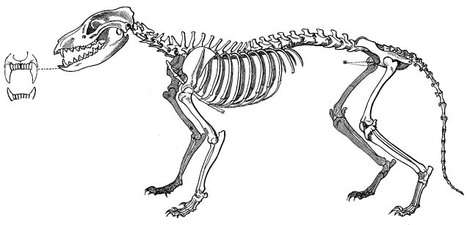
The thylacine was carnivorous. Prey is believed to have included kangaroos, wallabies and wombats, birds and small animals such as potoroos and possums. One prey animal may have been the once common Tasmanian emu.[64] The emu was a large, flightless bird which shared the habitat of the thylacine and was hunted to extinction by humans around 1850, possibly coinciding with the decline in thylacine numbers.[65] Both dingoes and foxes have been noted to hunt the emu on the mainland.[66][67] European settlers believed the thylacine to prey upon farmers' sheep and poultry.[68][69] Throughout the 20th century, the thylacine was often characterised as primarily a blood drinker; according to Robert Paddle, the story's popularity seems to have originated from a single second-hand account heard by Geoffrey Smith (1881–1916)[70][71] in a shepherd's hut.[72]
There is some controversy over the preferred prey size of the thylacine. A 2011 study by the University of New South Wales using advanced computer modelling indicated that the thylacine had surprisingly feeble jaws. Animals usually take prey close to their own body size, but an adult thylacine of around 30 kilograms (66 lb) was found to be incapable of handling prey much larger than 5 kilograms (11 lb). Thus, some researchers believe thylacines only ate small animals such as bandicoots and possums, putting them into direct competition with the Tasmanian devil and the tiger quoll. However, an earlier study showed that the thylacine had a bite force quotient of 166, similar to that of most quolls; in modern mammalian predators, such a high bite force is almost always associated with predators which routinely take prey as large, or larger than, themselves.[73] If the thylacine was indeed specialised for small prey, this specialisation likely made it susceptible to small disturbances to the ecosystem.[74]
Analysis of the skeletal frame and observations of the thylacine in captivity suggest that it preferred to single out a target animal and pursue that animal until it was exhausted: a pursuit predator. However, trappers reported it as an ambush predator:[41] the animal may have hunted in small family groups, with the main group herding prey in the general direction of an individual waiting in ambush.[21]
Although the living grey wolf is widely seen as the thylacine's counterpart, the thylacine may have been more of an ambush predator as opposed to a pursuit predator. In fact, the predatory behaviour of the thylacine was probably closer to ambushing felids than to large pursuit canids.
Its stomach was muscular, and could distend to allow the animal to eat large amounts of food at one time, probably an adaptation to compensate for long periods when hunting was unsuccessful and food scarce.[41]
In captivity, thylacines were fed a wide variety of foods, including dead rabbits and wallabies as well as beef, mutton, horse, and occasionally poultry.[75] There is a report of a captive thylacine which refused to eat dead wallaby flesh or to kill and eat a live wallaby offered to it, but "ultimately it was persuaded to eat by having the smell of blood from a freshly killed wallaby put before its nose."[76]
In 2017, Berns and Ashwell published comparative cortical maps of thylacine and Tasmanian devil brains, showing that the thylacine had a larger, more modularised basal ganglion. The authors associated these differences with the thylacine's predatory lifestyle.[77] The same year, White, Mitchell and Austin published a large-scale analysis of thylacine mitochondrial genomes, showing that they had split into Eastern and Western populations on the mainland prior to the Last Glacial Maximum and had low genetic diversity by the time of European arrival.[78]
Relationship with humans
Captivity
By the beginning of the 20th century, the increasing rarity of thylacines led to increased demand for captive specimens by zoos around the world.[79] Despite export of breeding pairs, these were unsuccessful and the last thylacine outside Australia died at London Zoo in 1931.[80]
Extinction in the Australian mainland

Australia lost more than 90% of its larger terrestrial vertebrates by around 40 thousand years ago, with the notable exceptions of the kangaroo and the thylacine.[81] A 2010 paper examining this issue showed that humans were likely to be one of the major factors in the extinction of many species in Australia although the authors of the research warned that one-factor explanations might be oversimplistic.[81] The thylacine itself likely neared extinction throughout most of its range in mainland Australia by about 2,000 years ago.[3]
However, reliable accounts of thylacine survival in South Australia (though confined to the "thinly settled districts" and Flinders Ranges) and New South Wales (Blue Mountains) exist from as late as the 1830s, from both indigenous and European sources.[82]
A study proposes that the arrival of the dingoes may have led to the extinction of the Tasmanian devil, the thylacine, and the Tasmanian nativehen in mainland Australia because the dingo might have competed with the thylacine and devil in preying on the native hen. However, the study also proposes that an increase in the human population that gathered pace around 4,000 years ago may have led to this.[83]
However, a counter-argument is that the two species were not in direct competition with one another because the dingo primarily hunts during the day, whereas it is thought that the thylacine hunted mostly at night. Nonetheless, recent morphological examinations of dingo and thylacine skulls show that although the dingo had a weaker bite, its skull could resist greater stresses, allowing it to pull down larger prey than the thylacine. The thylacine was less versatile in its diet than the omnivorous dingo.[84][85] Their ranges appear to have overlapped because thylacine subfossil remains have been discovered near those of dingoes. The adoption of the dingo as a hunting companion by the indigenous peoples would have put the thylacine under increased pressure.[83]
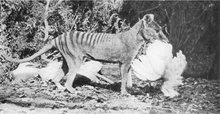
In fact the image is cropped to hide the fenced run and housing, and analysis by one researcher has concluded that this thylacine is a mounted specimen, posed for the camera.[upper-alpha 2]
Extinction in Tasmania
Although the thylacine was extinct on mainland Australia, it survived into the 1930s on the island state of Tasmania. At the time of the first European settlement, the heaviest distributions were in the northeast, northwest and north-midland regions of the state.[56] They were rarely sighted during this time but slowly began to be credited with numerous attacks on sheep. This led to the establishment of bounty schemes in an attempt to control their numbers. The Van Diemen's Land Company introduced bounties on the thylacine from as early as 1830, and between 1888 and 1909 the Tasmanian government paid £1 per head (the equivalent of £100 or more today [when?]) for dead adult thylacines and ten shillings for pups. In all, they paid out 2,184 bounties, but it is thought that many more thylacines were killed than were claimed for. Its extinction is popularly attributed to these relentless efforts by farmers and bounty hunters.[44][88]
However, it is likely that multiple factors led to its decline and eventual extinction, including competition with wild dogs introduced by European settlers,[89] erosion of its habitat, the concurrent extinction of prey species, and a distemper-like disease that affected many captive specimens at the time.[42][90] A study from 2012 also found that were it not for an epidemiological influence, the extinction of thylacine would have been at best prevented, at worst postponed. "The chance of saving the species, through changing public opinion, and the re-establishment of captive breeding, could have been possible. But the marsupi-carnivore disease, with its dramatic effect on individual thylacine longevity and juvenile mortality, came far too soon, and spread far too quickly."[91]
Whatever the reason, the animal had become extremely rare in the wild by the late 1920s. Despite the fact that the thylacine was believed by many to be responsible for attacks on sheep, in 1928 the Tasmanian Advisory Committee for Native Fauna recommended a reserve similar to the Savage River National Park to protect any remaining thylacines, with potential sites of suitable habitat including the Arthur-Pieman area of western Tasmania.[92]
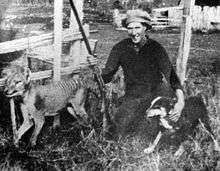
The last known thylacine to be killed in the wild was shot in 1930 by Wilf Batty, a farmer from Mawbanna in the state's northwest. The animal, believed to have been a male, had been seen around Batty's house for several weeks.[93][94]
Work in 2012 examined the relationship of the genetic diversity of the thylacines before their extinction. The results indicated that the last of the thylacines in Australia, on top of the threats from dingoes, had limited genetic diversity, due to their complete geographic isolation from mainland Australia.[95] Further investigations in 2017 showed evidence that this decline in genetic diversity started long before the arrival of humans in Australia, possibly starting as early as 70–120 thousand years ago.[96]
"Benjamin" and searches
The last captive thylacine, later referred to as "Benjamin", was trapped in the Florentine Valley by Elias Churchill in 1933, and sent to the Hobart Zoo where it lived for three years. The thylacine died on 7 September 1936. It is believed to have died as the result of neglect—locked out of its sheltered sleeping quarters, it was exposed to a rare occurrence of extreme Tasmanian weather: extreme heat during the day and freezing temperatures at night.[97] This thylacine features in the last known motion picture footage of a living specimen: 62 seconds of black-and-white footage showing the thylacine in its enclosure in a clip taken in 1933, by naturalist David Fleay.[98] In the film footage, the thylacine is seen seated, walking around the perimeter of its enclosure, yawning (exposing its impressive gape), sniffing the air, scratching itself (in the same manner as a dog), and lying down.[99]
Frank Darby, who claimed to have been a keeper at Hobart Zoo, suggested "Benjamin" as having been the animal's pet name in a newspaper article of May 1968. No documentation exists to suggest that it ever had a pet name, and Alison Reid (de facto curator at the zoo) and Michael Sharland (publicist for the zoo) denied that Frank Darby had ever worked at the zoo or that the name "Benjamin" was ever used for the animal. Darby also appears to be the source for the claim that the last thylacine was a male.[100] Robert Paddle was unable to uncover any records of any Frank Darby having been employed by Beaumaris/Hobart Zoo during the time that Reid or her father was in charge and noted several inconsistencies in the story Darby told during his interview in 1968.
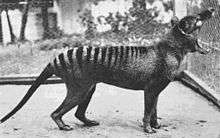
The sex of the last captive thylacine has been a point of debate since its death at the Beaumaris Zoo in Hobart, Tasmania. In 2011, a detailed examination of a single frame from the motion film footage confirmed that the thylacine was male. When frame III is enlarged the scrotum can be seen, confirming the thylacine to be male. By enhancing the frame, the outline of the individual testes is discernable.[101]
After the thylacine's death the zoo expected that it would soon find a replacement,[93] and "Benjamin"'s death was not reported on in the media at the time.[102] Although there had been a conservation movement pressing for the thylacine's protection since 1901, driven in part by the increasing difficulty in obtaining specimens for overseas collections, political difficulties prevented any form of protection coming into force until 1936. Official protection of the species by the Tasmanian government was introduced on 10 July 1936, 59 days before the last known specimen died in captivity.[103]
A thylacine was reportedly shot and photographed at Mawbanna in 1938. A 1957 sighting from a helicopter could not be confirmed on the ground. An animal killed in Sandy Cape at night in 1961 was tentatively identified as a thylacine.[93] The results of subsequent searches indicated a strong possibility of the survival of the species in Tasmania into the 1960s. Searches by Dr. Eric Guiler and David Fleay in the northwest of Tasmania found footprints and scats that may have belonged to the animal, heard vocalisations matching the description of those of the thylacine, and collected anecdotal evidence from people reported to have sighted the animal.
Despite the searches, no conclusive evidence was found to point to its continued existence in the wild.[33] Between 1967 and 1973, zoologist Jeremy Griffith and dairy farmer James Malley conducted what is regarded as the most intensive search ever carried out, including exhaustive surveys along Tasmania's west coast, installation of automatic camera stations, prompt investigations of claimed sightings, and in 1972 the creation of the Thylacine Expeditionary Research Team with Dr. Bob Brown, which concluded without finding any evidence of the thylacine's existence.[104]
The thylacine held the status of endangered species until the 1980s. International standards at the time stated that an animal could not be declared extinct until 50 years had passed without a confirmed record. Since no definitive proof of the thylacine's existence in the wild had been obtained for more than 50 years, it met that official criterion and was declared extinct by the International Union for Conservation of Nature in 1982[3] and by the Tasmanian government in 1986. The species was removed from Appendix I of the Convention on International Trade in Endangered Species of Wild Fauna and Flora (CITES) in 2013.[105]
Unconfirmed sightings
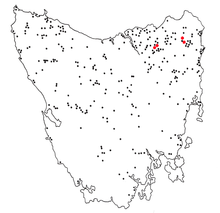
The Department of Conservation and Land Management recorded 203 reports of sightings of the Thylacine in Western Australia from 1936 to 1998.[59] On the mainland, sightings are most frequently reported in Southern Victoria.[106]
In 1982, a researcher with the Tasmania Parks and Wildlife Service, Hans Naarding, observed what he believed to be a thylacine for three minutes during the night at a site near Arthur River in northwestern Tasmania. The sighting led to an extensive year-long government-funded search.[107] In 1985, Aboriginal tracker Kevin Cameron produced five photographs which appear to show a digging thylacine, which he stated he took in Western Australia.[108]
In January 1995, a Parks and Wildlife officer reported observing a thylacine in the Pyengana region of northeastern Tasmania in the early hours of the morning. Later searches revealed no trace of the animal.[109] In 1997, it was reported that locals and missionaries near Mount Carstensz in Western New Guinea had sighted thylacines.[110][111] The locals had apparently known about them for many years but had not made an official report.[112] In February 2005 Klaus Emmerichs, a German tourist, claimed to have taken digital photographs of a thylacine he saw near the Lake St Clair National Park, but the authenticity of the photographs has not been established.[113] The photos were published in April 2006, fourteen months after the sighting. The photographs, which showed only the back of the animal, were said by those who studied them to be inconclusive as evidence of the thylacine's continued existence.[114]
In light of two detailed sightings around 1983 from the remote Cape York Peninsula of mainland Australia, scientists led by Bill Laurance announced plans in 2017 to survey the area for thylacines using camera traps.[115][116]
In 2017, 580 camera traps were deployed in North Queensland by James Cook University after two reputable sources (an experienced outdoorsman and a former Park Ranger) reported having seen a thylacine there in the 1980s and have been too embarrassed to tell anyone.[117][118]
According to the Department of Primary Industries, Parks, Water and Environment, there have been eight unconfirmed thylacine sighting reports between 2016 and 2019, with the latest unconfirmed visual sighting on 25 February 2018.[119]
Since the disappearance and effective extinction of the thylacine, speculation, and searches for a living specimen has become a topic of interest to some members of the cryptozoology subculture.[120] The search for the animal has been the subject of books and articles, with many reported sightings that are largely regarded as dubious. According to writer Errol Fuller, the most likely record of the species persistence was proposed by Athol Douglas in the journal Cryptozoology, where Douglas challenges the carbon dating of the specimen found at Mundrabilla in South Australia as 4,500 years old; Douglas proposed instead that the well-preserved thylacine carcass was several months old when discovered. The dating of the specimen has not been reassessed.[121]
Rewards
In 1983, the American media mogul Ted Turner offered a $100,000 reward for proof of the continued existence of the thylacine.[122]
A letter sent in response to an inquiry by a thylacine-searcher, Murray McAllister in 2000, indicated that the reward had been withdrawn.[123] In March 2005, Australian news magazine The Bulletin, as part of its 125th anniversary celebrations, offered a $1.25 million reward for the safe capture of a live thylacine. When the offer closed at the end of June 2005, no one had produced any evidence of the animal's existence. An offer of $1.75 million has subsequently been offered by a Tasmanian tour operator, Stewart Malcolm.[114] Trapping is illegal under the terms of the thylacine's protection, so any reward made for its capture is invalid, since a trapping license would not be issued.[122]
Research

The Australian Museum in Sydney began a cloning project in 1999.[124] The goal was to use genetic material from specimens taken and preserved in the early 20th century to clone new individuals and restore the species from extinction. Several molecular biologists have dismissed the project as a public relations stunt and its chief proponent, Mike Archer, received a 2002 nomination for the Australian Skeptics Bent Spoon Award for "the perpetrator of the most preposterous piece of paranormal or pseudo-scientific piffle."[125]
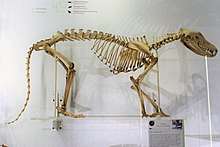
In late 2002, the researchers had some success as they were able to extract replicable DNA from the specimens.[126] On 15 February 2005, the museum announced that it was stopping the project after tests showed the DNA retrieved from the specimens had been too badly degraded to be usable.[127][128] In May 2005, Archer, the University of New South Wales Dean of Science at the time, former director of the Australian Museum and evolutionary biologist, announced that the project was being restarted by a group of interested universities and a research institute.[114][129]
In 2008, researchers Andrew J. Pask and Marilyn B. Renfree from the University of Melbourne and Richard R. Behringer from the University of Texas at Austin reported that they managed to restore functionality of a gene Col2A1 enhancer obtained from 100-year-old ethanol-fixed thylacine tissues from museum collections. The genetic material was found working in transgenic mice. The research enhanced hopes of eventually restoring the population of thylacines.[130][131] That same year, another group of researchers successfully sequenced the complete thylacine mitochondrial genome from two museum specimens. Their success suggests that it may be feasible to sequence the complete thylacine nuclear genome from museum specimens. Their results were published in the journal Genome Research in 2009.[35]
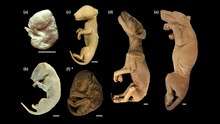
The palaeontologist Mike Archer reported about the possibilities of resurrecting the thylacine and the gastric-brooding frog at TED2013.[132] Stewart Brand spoke at TED2013 about the ethics and possibilities of de-extinction, and made reference to thylacine in his talk.[133] A draft genome sequence of the thylacine was produced by Feigin et al. 2017 using the DNA extracted from an ethanol-preserved pouch young specimen provided by Museums Victoria. Researchers used the genome to study aspects of the thylacine's evolution and natural history, including the genetic basis of its convergence with canids, clarifying its evolutionary relationships with other marsupials and examining changes in its population size over time.[134]
Also in 2017 a reference library of 159 micrographic images of thylacine hair was jointly produced by CSIRO and Where Light Meets Dark, using scanning electron microscopy, metal-coated scanning electron microscopy, confocal laser scanning microscopy and optical light microscopy.[135] In 2018 Rehberg published a study into the appearance of thylacine stripes using infrared flash camera trap photography.[136]
Cultural significance
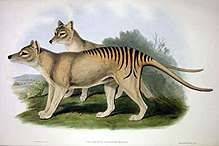
Since 1996,[137] 7 September (the date in 1936 on which the last known thylacine died) has been commemorated in Australia as National Threatened Species Day.[138]
The best known illustrations of Thylacinus cynocephalus were those in Gould's The Mammals of Australia (1845–63), often copied since its publication and the most frequently reproduced,[139] and given further exposure by Cascade Brewery's appropriation for its label in 1987.[140] The government of Tasmania published a monochromatic reproduction of the same image in 1934,[141] the author Louisa Anne Meredith also copied it for Tasmanian Friends and Foes (1881).[139]

The thylacine has been used extensively as a symbol of Tasmania. The animal is featured on the official Tasmanian coat of arms.[142] It is used in the official logos for the Tasmanian government and the City of Launceston.[142] It is also used on the University of Tasmania's ceremonial mace and the badge of the submarine HMAS Dechaineux.[142] Since 1998, it has been prominently displayed on Tasmanian vehicle number plates.
The plight of the thylacine was featured in a campaign for The Wilderness Society entitled We used to hunt thylacines. In video games, boomerang-wielding Ty the Tasmanian Tiger is the star of his own trilogy. Characters in the early 1990s cartoon Taz-Mania included the neurotic Wendell T. Wolf, the last surviving Tasmanian wolf. Tiger Tale is a children's book based on an Aboriginal myth about how the thylacine got its stripes. The thylacine character Rolf is featured in the extinction musical Rockford's Rock Opera. The thylacine is the mascot for the Tasmanian cricket team,[142] and has appeared in postage stamps from Australia, Equatorial Guinea, and Micronesia.[143]
The Hunter is a novel by Julia Leigh about an Australian hunter who sets out to find the last thylacine. The novel has been adapted into a 2011 film by the same name directed by Daniel Nettheim, and starring Willem Dafoe.[144]
See also
- De-extinction / Breeding back
- Fauna of Australia
- List of extinct animals of Australia
- Savage River National Park
References
Notes
Citations
- Groves, C.P. (2005). "Order Dasyuromorphia". In Wilson, D.E.; Reeder, D.M (eds.). Mammal Species of the World: A Taxonomic and Geographic Reference (3rd ed.). Johns Hopkins University Press. p. 23. ISBN 978-0-8018-8221-0. OCLC 62265494.
- Piper, Katarzyna J. (2007). "Early Pleistocene mammals from the Nelson Bay local fauna, Portland, Victoria, Australia". Journal of Vertebrate Paleontology. 27 (2): 492–503. doi:10.1671/0272-4634(2007)27[492:EPMFTN]2.0.CO;2.
- Burbidge, A. A.; Woinarski, J. (2016). "Thylacinus cynocephalus". IUCN Red List of Threatened Species. 2016: e.T21866A21949291. doi:10.2305/IUCN.UK.2016-2.RLTS.T21866A21949291.en. Retrieved 16 December 2019.
- Harris, G. P. (1808). "Description of two new Species of Didelphis from Van Diemen's Land". Transactions of the Linnean Society of London. 9 (1): 174–178. doi:10.1111/j.1096-3642.1818.tb00336.x. Archived from the original on 2 August 2017. Retrieved 21 February 2018.
- Paddle (2000)
- Geoffroy-Saint-Hilaire, [Étienne] (1810). "Description de deux espèces de Dasyures (Dasyurus cynocephalus et Dasyurus ursinus)". Annales du Muséum National d'Histoire Naturelle. 15: 301–306. Archived from the original on 2 August 2017. Retrieved 21 February 2018.
- Temminck, C. J. (1827). "Thylacine de Harris. – Thylacinus harrisii". Monographies de mammalogie. 1. Paris: G. Dufour et Ed. d'Ocagne. pp. 63–65.
- Grant, J. (1831). "Notice of the Van Diemen's Land Tiger". Gleanings in Science. 3 (30): 175–177. Archived from the original on 2 August 2017. Retrieved 21 February 2018.
- Warlow, W. (1833). "Systematically arranged Catalogue of the Mammalia and Birds belonging to the Museum of the Asiatic Society, Calcutta". The Journal of the Asiatic Society of Bengal. 2 (14): 97. Archived from the original on 2 August 2017. Retrieved 21 February 2018.
- "Genus Thylacinus, Temm.". Descriptive Catalogue of the Specimens of Natural History in Spirit Contained in the Museum of the Royal College of Surgeons of England. Vertebrata: Pisces, Reptilia, Aves, Mammalia. London: Taylor and Francis. 1859. p. 147.
- Krefft, Gerard (1868). "Description of a new species of Thylacine (Thylacinus breviceps)". The Annals and Magazine of Natural History. Fourth Series. 2 (10): 296–297. doi:10.1080/00222936808695804. Archived from the original on 2 August 2017. Retrieved 21 February 2018.
- De Vis, C.W. (1894). "A thylacine of the earlier nototherian period in Queensland". Proceedings of the Linnean Society of New South Wales. 8: 443–447. Archived from the original on 8 August 2019. Retrieved 8 August 2019.
- Macquarie ABC Dictionary. The Macquarie Library Pty Ltd. 2003. p. 1032. ISBN 978-1-876429-37-9.
- "thylacine". Oxford English Dictionary (3rd ed.). Oxford University Press. September 2005. (Subscription or UK public library membership required.)
- "thylacine". Dictionary.com Unabridged (v 1.1). Random House, Inc. 30 May 2009.
- Salleh, Anna (15 December 2004). "Rock art shows attempts to save thylacine". ABC Science Online. Archived from the original on 16 April 2015. Retrieved 21 November 2006.
- Rembrants. D. (1682) "A short relation out of the journal of Captain Abel Jansen Tasman, upon the discovery of the South Terra incognita; not long since published in the Low Dutch". Philosophical Collections of the Royal Society of London, (6), 179–186. Quoted in Paddle (2000), p. 3.
- Roth, H. L. (1891) "Crozet's Voyage to Tasmania, New Zealand, etc ... 1771–1772.". London. Truslove and Shirley. Quoted in Paddle (2000), p. 3.
- Paddle (2000), p. 3.
- Description of a Tasmanian Tiger Received by Banks from William Paterson, 30 March 1805. (n.d.). Sir Joseph Banks Papers, State Library of New South Wales, SAFE/Banks Papers/Series 27.33 Archived 9 February 2019 at the Wayback Machine
- "Information sheet: Thylacine Thylacinus cynocephalus" (PDF). Victoria Museum. April 2005. Archived from the original (PDF) on 9 November 2006. Retrieved 21 November 2006.
- "Thylacinus cynocephalus (Harris, 1808)". Australian Faunal Directory. ABRS. 9 October 2008. Archived from the original on 4 October 2012. Retrieved 2 May 2009.
- Paddle (2000), p. 5.
- Hoad, T. F., ed. (1986). The Concise Oxford Dictionary of English Etymology. Oxford: Oxford University Press. ISBN 978-0-19-863120-0.
- Werdelin, L. (1986). "Comparison of Skull Shape in Marsupial and Placental Carnivores". Australian Journal of Zoology. 34 (2): 109–117. doi:10.1071/ZO9860109.
- Mackness, B. S., et al. "Confirmation of Thylacinus from the Pliocene Chinchilla Local Fauna." Australian Mammalogy 24.2 (2002): 237-242.
- Jackson, S.M.; Groves, C. (2015). Taxonomy of Australian Mammals. Csiro Publishing. p. 77. ISBN 9781486300136.
- "Riversleigh". Australian Museum. 1999. Archived from the original on 14 June 2006. Retrieved 21 November 2006.
- "Is there a fossil Thylacine?". Australian Museum. 1999. Archived from the original on 2 June 2009. Retrieved 21 November 2006.
- "Lost Kingdoms: Dickson's Thylacine (Nimbacinus dicksoni)". Australian Museum. 1999. Archived from the original on 19 March 2006. Retrieved 21 November 2006.
- "Lost Kingdoms: Powerful Thylacine (Thylacinus potens)". Australian Museum. 1999. Archived from the original on 25 March 2005. Retrieved 21 November 2006.
- Johnson, C. N.; Wroe, S. (November 2003). "Causes of extinction of vertebrates during the Holocene of mainland Australia: arrival of the dingo, or human impact?". The Holocene. 13 (6): 941–948. Bibcode:2003Holoc..13..941J. doi:10.1191/0959683603hl682fa.
- "Threatened Species: Thylacine – Tasmanian tiger, Thylacinus cynocephalus" (PDF). Parks and Wildlife Service, Tasmania. December 2003. Archived from the original (PDF) on 2 October 2006. Retrieved 22 November 2006.
- Dawkins, Richard (2016). The Ancestor's Tale. Mariner Books. p. 277.
- Miller, W; Drautz, DI; Janecka, JE; et al. (February 2009). "The mitochondrial genome sequence of the Tasmanian tiger (Thylacinus cynocephalus)". Genome Res. 19 (2): 213–220. doi:10.1101/gr.082628.108. PMC 2652203. PMID 19139089.
- Bryant, Sally; Jackson, Jean; Threatened Species Unit, Parks & Wildlife Service, Tasmania (1999). Tasmania's Threatened Fauna Handbook. Bryant and Jackson. pp. 190–193. ISBN 978-0-7246-6223-4.
- Jones, Menna (1997). "Character displacement in Australian dasyurid carnivores: size relationships and prey size patterns". Ecology. 78 (8): 2569–2587. doi:10.1890/0012-9658(1997)078[2569:CDIADC]2.0.CO;2.
- Campbell, Cameron. "The Thylacine Museum – Biology: Anatomy: Skull and Skeleton: Post-cranial Skeleton (page 1)". Archived from the original on 3 April 2016. Retrieved 15 June 2016.
- Ronald M. Nowak, Walker's Marsupials of the World, JHU Press, 12/09/2005
- Marshall, L. Evolution of the Borhyaenidae, extinct South American predaceous marsupials. Berkeley: University of California Press, 1978.
- Dixon, Joan. "Fauna of Australia chap.20 vol.1b" (PDF). Australian Biological Resources Study (ABRS). Archived from the original (PDF) on 8 January 2009. Retrieved 22 November 2006.
- Guiler, Eric (2006). "Profile – Thylacine". Zoology Department, University of Tasmania. Archived from the original on 18 July 2005. Retrieved 21 November 2006.
- "Australia's Thylacine: What did the Thylacine look like?". Australian Museum. 1999. Archived from the original on 24 October 2009. Retrieved 21 November 2006.
- "Wildlife of Tasmania: Mammals of Tasmania: Thylacine, or Tasmanian tiger, Thylacinus cynocephalus". Parks and Wildlife Service, Tasmania. 2006. Archived from the original on 21 July 2008. Retrieved 21 November 2006.
- AFP (21 October 2003). "Extinct Thylacine May Live Again". Discovery Channel. Archived from the original on 8 October 2012. Retrieved 28 November 2007.
- "Tasmanian Tiger's Jaw Was Too Small to Attack Sheep, Study Shows" Archived 23 March 2019 at the Wayback Machine. Science Daily. 1 September 2011.
- "Tasmanian tiger was no sheep killer" Archived 4 January 2012 at the Wayback Machine. ABC Science. 1 September 2011.
- "The Thylacine Museum: External Antatomy". Archived from the original on 21 June 2017. Retrieved 25 January 2019.
- The scrotal pouch is almost unique within the marsupials – the only other marsupial species to have this feature is the water opossum, Chironectes minimus which is found in Mexico, Central and South America.
- "Foot cast of a freshly dead thylacine: Thylacine, or Tasmanian tiger, Thylacinus cynocephalus". Victoria Museum, Victoria. 2015. Archived from the original on 7 October 2015. Retrieved 6 October 2015.
- Paddle (2000), p. 49.
- "Tasmanian Tiger". Archives Office of Tasmania. 1930. Archived from the original on 12 July 2012. Retrieved 27 November 2006.
- Paddle (2000), pp. 65–66.
- "Mummified thylacine has national message". National Museum of Australia, Canberra. 16 June 2004. Archived from the original on 10 November 2013. Retrieved 21 November 2006.
- Fedorowytsch T.. 2017. Fossil footprints reveal Kangaroo Island's diverse ancient wildlife Archived 24 July 2017 at the Wayback Machine. ABC Net News. Retrieved on July 24, 2017
- "Australia's Thylacine: Where did the Thylacine live?". Australian Museum. 1999. Archived from the original on 2 June 2009. Retrieved 21 November 2006.
- Paddle (2000), pp. 42–43.
- Paddle (2000), pp. 38–39.
- Heberle, G. (1977). "Reports of alleged thylacine sightings in Western Australia" (PDF). Sunday Telegraph: 46. Archived from the original (w) on 21 May 2013. Retrieved 5 February 2012.
- Tasmanian tigers brought to life Archived 12 March 2011 at the Wayback Machine, Australian Geographic, 24 February 2011.
- Paddle (2000), p. 60.
- Paddle (2000), pp. 228–231.
- Newton, Axel H.; Spoutil, Frantisek; Prochazka, Jan; Black, Jay R.; Medlock, Kathryn; Paddle, Robert N.; Knitlova, Marketa; Hipsley, Christy A.; Pask, Andrew J. (21 February 2018). "Letting the 'cat' out of the bag: pouch young development of the extinct Tasmanian tiger revealed by X-ray computed tomography". Royal Society Open Science. 5 (2): 171914. Bibcode:2018RSOS....571914N. doi:10.1098/rsos.171914. PMC 5830782. PMID 29515893.
- Some writers go further to postulate that the mature thylacine's jaw and bipedal hop were specialised for hunting the emu and either breaking its neck or severing the jugular vein.
- Paddle (2000), pp. 81.
- Pople, A. R; Grigg, G. C; Cairns, S. C; Beard, L. A; Alexander, P (2000). "Trends in the numbers of red kangaroos and emus on either side of the South Australian dingo fence: evidence for predator regulation?" (PDF). Wildlife Research. 27 (3): 269–276. doi:10.1071/WR99030. Archived (PDF) from the original on 6 March 2016. Retrieved 16 March 2019.
- "Emu". Archived from the original on 17 March 2014. Retrieved 19 September 2006.
- Based on the lack of reliable first hand accounts, Robert Paddle argues that the predation on sheep and poultry may have been exaggerated, suggesting the thylacine was used as a convenient scapegoat for the mismanagement of the sheep farms, and the image of it as a poultry killer impressed on the public consciousness by a striking photo taken by Henry Burrell in 1921.
- Paddle (2000), pp. 79–138.
- Smith, Geoffrey Watkins (1909) "A Naturalist in Tasmania." Archived 10 September 2014 at the Wayback Machine. Clarendon Press: Oxford.
- "Smith, Geoffrey Watkins" Archived 3 November 2014 at the Wayback Machine. winchestercollegeatwar.com.
- Paddle (2000), pp. 29–35.
- Wroe, S.; McHenry, C.; Thomason, J. (2005). "Bite club: Comparative bite force in big biting mammals and the prediction of predatory behaviour in fossil taxa". Proceedings of the Royal Society B: Biological Sciences. 272 (1563): 619–625. doi:10.1098/rspb.2004.2986. PMC 1564077. PMID 15817436.
- Attard, M. R. G.; Chamoli, U.; Ferrara, T. L.; Rogers, T. L.; Wroe, S. (2011). "Skull mechanics and implications for feeding behaviour in a large marsupial carnivore guild: The thylacine, Tasmanian devil and spotted-tailed quoll". Journal of Zoology. 285 (4): 292. doi:10.1111/j.1469-7998.2011.00844.x.
- Paddle (2000), p. 96.
- Paddle (2000), p. 32.
- Berns, Gregory S.; Ashwell, Ken W. S. (18 January 2017). "Reconstruction of the Cortical Maps of the Tasmanian Tiger and Comparison to the Tasmanian Devil". PLOS One. 12 (1): e0168993. Bibcode:2017PLoSO..1268993B. doi:10.1371/journal.pone.0168993. ISSN 1932-6203. PMC 5242427. PMID 28099446.
- White, Lauren C.; Mitchell, Kieren J.; Austin, Jeremy J. (2018). "Ancient mitochondrial genomes reveal the demographic history and phylogeography of the extinct, enigmatic thylacine (Thylacinus cynocephalus)". Journal of Biogeography. 45: 1–13. doi:10.1111/jbi.13101. ISSN 1365-2699.
- Department of the Environment (2018). Thylacinus cynocephalus Archived 8 April 2018 at the Wayback Machine in Species Profile and Threats Database, Department of the Environment, Canberra. Retrieved 7 April 2018.
- The hunt for London's thylacines shows a greater truth about Australian extinction Archived 7 April 2018 at the Wayback Machine The Conversation, 6 April 2018. Retrieved 7 April 2018.
- Prideaux, Gavin J.; Gully, Grant A.; Couzens, Aidan M. C.; Ayliffe, Linda K.; Jankowski, Nathan R.; Jacobs, Zenobia; Roberts, Richard G.; Hellstrom, John C.; Gagan, Michael K.; Hatcher, Lindsay M. (December 2010). "Timing and dynamics of Late Pleistocene mammal extinctions in southwestern Australia". Proceedings of the National Academy of Sciences. 107 (51): 22157–22162. Bibcode:2010PNAS..10722157P. doi:10.1073/pnas.1011073107. PMC 3009796. PMID 21127262.
- Paddle (2000), pp. 23–24.
- Johnson, CN; Wroe, S. (September 2003). "Causes of Extinction of Vertebrates during the Holocene of Mainland Australia: Arrival of the Dingo, or Human Impact?". The Holocene. 13 (6): 941–948. Bibcode:2003Holoc..13..941J. doi:10.1191/0959683603hl682fa.
- "Tiger's demise: Dingo did do it". The Sydney Morning Herald. 6 September 2007. Archived from the original on 7 October 2008. Retrieved 3 November 2008.
- Wroe, Stephen; Clausen, Philip; McHenry, Colin; Moreno, Karen; Cunningham, Eleanor (2007). "Computer simulation of feeding behaviour in the thylacine and dingo as a novel test for convergence and niche overlap". Proceedings of the Royal Society B. 274 (1627): 2819–2828. doi:10.1098/rspb.2007.0906. PMC 2288692. PMID 17785272.
- Freeman, Carol (June 2005). "Is this picture worth a thousand words? An analysis of Henry Burrell's photograph of a thylacine with a chicken" (PDF). Australian Zoologist. 33 (1): 1–15. doi:10.7882/AZ.2005.001. Archived from the original (PDF) on 5 September 2012.
- See Freeman, Carol (2014). Paper Tiger: How Pictures Shaped the Thylacine (illustrated ed.). Hobart, Tasmania: Forty South Publishing. ISBN 978-0992279172.
- Jarvis, Brooke (2 July 2018). "The Obsessive Search for the Tasmanian Tiger Could a global icon of extinction still be alive?". The New Yorker. Archived from the original on 15 March 2019. Retrieved 30 March 2019.
- Boyce, James (2006). "Canine Revolution: The Social and Environmental Impact of the Introduction of the Dog to Tasmania". Environmental History. 11 (1): 102–129. doi:10.1093/envhis/11.1.102. Archived from the original on 18 September 2009.
- Paddle (2000), pp. 202–203.
- Paddle, R. (2012). "The thylacine's last straw: Epidemic disease in a recent mammalian extinction". Australian Zoologist. 36 (1): 75–92. doi:10.7882/az.2012.008. Archived from the original on 18 November 2018. Retrieved 15 December 2014.
- "Pelt of a thylacine shot in the Pieman River-Zeehan area of Tasmania in 1930: Charles Selby Wilson collection". National Museum of Australia, Canberra. Archived from the original on 22 March 2012. Retrieved 9 January 2012.
- Ley, Willy (December 1964). "The Rarest Animals". For Your Information. Galaxy Science Fiction. pp. 94–103.
- "History – Persecution – (page 10)". The Thylacine Museum. 2006. Archived from the original on 20 December 2014. Retrieved 27 November 2006.
- Menzies, Brandon R.; Renfree, Marilyn B.; Heider, Thomas; Mayer, Frieder; Hildebrandt, Thomas B.; Pask, Andrew J. (18 April 2012). "Limited Genetic Diversity Preceded Extinction of the Tasmanian Tiger". PLoS ONE. 7 (4): e35433. Bibcode:2012PLoSO...735433M. doi:10.1371/journal.pone.0035433. PMC 3329426. PMID 22530022.
- Feigin, Charles Y.; Newton, Alex H.; Doronina, Liliya; et al. (11 December 2017). "Genome of the Tasmanian tiger provides insights into the evolution and demography of an extinct marsupial carnivore". Nature Ecology & Evolution. 2 (1): 182–192. doi:10.1038/s41559-017-0417-y. PMID 29230027.
- Paddle (2000), p. 195.
- Dayton, Leigh (19 May 2001). "Rough Justice". New Scientist. Archived from the original on 13 September 2009. Retrieved 15 February 2010.
- Fleay was bitten on the buttock whilst shooting the film, having ignored the threat yawn and hissing vocalizations made by the animal.
- Paddle (2000), pp. 198–201.
- Sleightholme, Stephen (2011). "Confirmation of the gender of the last captive Thylacine". Australian Zoologist. 35 (4): 953–956. doi:10.7882/AZ.2011.047.
- Edmonds, Penny; Stark, Hannah (6 April 2018). "'Specimen 91' and the hunt for London's thylacines". ABC News. Archived from the original on 6 April 2018. Retrieved 5 April 2018.
- Paddle (2000), p. 184.
- Park, Andy (July 1986). "Tasmanian tiger – extinct or merely elusive?". Australian Geographic. 1 (3): 66–83.
- "Amendments to Appendices I and II of the Convention" (PDF). Convention on International Trade in Endangered Species of Wild Fauna and Flora. 19 April 2013. Archived (PDF) from the original on 22 July 2015. Retrieved 16 December 2014.
- "Thyla seen near CBD?". The Sydney Morning Herald. 18 August 2003. Archived from the original on 6 November 2012. Retrieved 15 February 2010.
- "Mystery that burns so bright". The Sydney Morning Herald. 9 May 2000. Archived from the original on 15 October 2007. Retrieved 15 February 2010.
- Douglas, Athol (1985). "Tigers in Western Australia". New Scientist. 110 (1505): 44–47. Retrieved 16 October 2012.
- Woodford, James (30 January 1995). "New bush sighting puts tiger hunter back in business". The Sydney Morning Herald. Archived from the original on 24 March 2006. Retrieved 21 November 2006.
- Dingoes, the thylacine's possible competitor, are now rare, if not extinct, in Western New Guinea.
- Corbett, L. K. (2004). "Canis lupus ssp. dingo". IUCN Red List of Threatened Species. 2004. Retrieved 21 November 2006.CS1 maint: ref=harv (link)
- Williams, Louise (15 April 1997). "Tassie tiger sighting claim in Irian Jaya". The Sydney Morning Herald. Archived from the original on 24 March 2006. Retrieved 21 November 2006.
- "Tourist claims to have snapped Tasmanian tiger". The Sydney Morning Herald. 1 March 2005. Archived from the original on 2 January 2007. Retrieved 21 November 2006.
- Dasey, Daniel (15 May 2005). "Researchers revive plan to clone the Tassie tiger". The Sydney Morning Herald. Archived from the original on 9 August 2017. Retrieved 22 November 2006.
- "Why Scientists Are Resuming the Search for Extinct Tasmanian Tiger". Observer. 5 April 2017. Archived from the original on 18 April 2017. Retrieved 17 April 2017.
- Graham Lawton (6 May 2017). "Eye on the tiger". New Scientist.
- "The New Yorker - The Obsessive Search for the Tasmanian Tiger". Archived from the original on 15 March 2019. Retrieved 30 March 2019.
- "The Guardian - 'Sightings' of extinct Tasmanian tiger prompt search in Queensland". Archived from the original on 2 May 2019. Retrieved 2 May 2019.
- Dalton, Jane. "The last Tasmanian tiger is thought to have died more than 80 years ago. But 8 recent sightings suggest the creature may not be gone". Business Insider.
- Loxton, Daniel and Donald Prothero. Abominable Science!: Origins of the Yeti, Nessie, and Other Famous Cryptids, p. 323 & 327. Columbia University Press. ISBN 978-0-231-15321-8
- Fuller, Errol (2013). Lost animals: extinction and the photographic record. London: Bloomsbury. pp. 170, 178. ISBN 9781408172155.
- Steger, Jason (26 March 2005). "Extinct or not, the story won't die". The Age. Melbourne. Archived from the original on 8 January 2007. Retrieved 22 November 2006.
- McAllister, Murray (2000). "Reward Monies Withdrawn". Archived from the original on 13 December 2007. Retrieved 22 November 2006.
- Leigh, Julia (30 May 2002). "Back from the dead". The Guardian. London. Retrieved 22 November 2006.
- "Tasmanian tiger clone a fantasy: scientist". The Age. 22 August 2002. Archived from the original on 24 March 2008. Retrieved 28 December 2006.
- "Attempting to make a genomic library of an extinct animal". Australian Museum. 1999. Archived from the original on 14 April 2010. Retrieved 22 November 2006.
- "Museum ditches thylacine cloning project". ABC News Online. 15 February 2005. Archived from the original on 15 October 2008. Retrieved 22 November 2006.
- Smith, Deborah (17 February 2005). "Tassie tiger cloning 'pie-in-the-sky science'". The Sydney Morning Herald. Archived from the original on 24 March 2006. Retrieved 22 November 2006.
- Skatssoon, Judy (15 February 2005). "Thylacine cloning project dumped". ABC Science Online. Archived from the original on 17 February 2005. Retrieved 22 November 2006.
- Pask, A. J.; Behringer, R. R.; Renfree, M. B. (2008). "Resurrection of DNA function in vivo from an extinct genome". PLOS One. 3 (5): e2240. Bibcode:2008PLoSO...3.2240P. doi:10.1371/journal.pone.0002240. PMC 2375112. PMID 18493600.
- Sanderson, Katharine (20 May 2008). "Tasmanian tiger gene lives again". Nature News. doi:10.1038/news.2008.841.
- Archer, Mike (March 2013). " Archived 5 November 2014 at the Wayback Machine. ted.com.
- Brand, Stewart (February 2013). "Stewart Brand: The dawn of de-extinction. Are you ready?" Archived 4 October 2013 at the Wayback Machine. ted.com.
- Feigin, Charles Y.; Newton, Axel H.; Doronina, Liliya; et al. (11 December 2017). "Genome of the Tasmanian tiger provides insights into the evolution and demography of an extinct marsupial carnivore". Nature Ecology & Evolution. 2 (1): 182–192. doi:10.1038/s41559-017-0417-y. PMID 29230027.
- Rehberg, C. (2017) Photomicrographs of thylacine hair Archived 14 January 2018 at the Wayback Machine. http://www.wherelightmeetsdark.com.au Archived 14 January 2018 at the Wayback Machine.
- Rehberg, C. (2018) Infrared flash camera trap photography of a thylacine taxidermy Archived 14 January 2018 at the Wayback Machine. http://www.wherelightmeetsdark.com.au Archived 14 January 2018 at the Wayback Machine.
- "Threatened Species Day". NSW Environment & Heritage. Archived from the original on 6 April 2018. Retrieved 5 April 2018.
- "National Threatened Species Day". www.aph.gov.au. Archived from the original on 6 April 2018. Retrieved 5 April 2018.
- University Librarian (24 September 2007). "The Exotic Thylacine". Imaging the Thylacine. University of Tasmania. Archived from the original on 5 October 2009. Retrieved 30 April 2009.
- Stephens, Matthew; Williams, Robyn (13 June 2004). "John Gould's place in Australian culture". Ockham's Razor. Australian Broadcasting Corporation. Archived from the original on 5 February 2010. Retrieved 28 April 2009.
- Government Tourist Bureau, Tasmania. Tasmania: The Wonderland. Hobart: Government Printer, Tasmania, 1934
- "Imaging the Thylacine". University of Tasmania. 24 September 2007. Archived from the original on 16 September 2010. Retrieved 13 April 2010.
- Burns, Philip R. (6 July 2003). "Thylacine Stamps". Archived from the original on 18 August 2003. Retrieved 21 November 2006.
- Wigney, James (25 September 2011). "The Hunter enchanted". Herald Sun. Archived from the original on 15 August 2014. Retrieved 27 September 2011.
Bibliography
- Paddle, Robert (2000). The Last Tasmanian Tiger: the History and Extinction of the Thylacine. Cambridge University Press. ISBN 978-0-521-53154-2.
Further reading
- Bailey, C. (2013) Shadow of the Thylacine. Five mile press. ISBN 978-1-74346-485-4
- Freeman, Carol (2014). Paper Tiger: How Pictures Shaped the Thylacine (illustrated ed.). Hobart, Tasmania: Forty South Publishing. ISBN 978-0992279172.
- Guiler, E. (1985) Thylacine: The Tragedy of the Tasmanian Tiger. Oxford University Press. ISBN 978-0-19-554603-3
- Guiler, E. & Godard, P. (1998) Tasmanian Tiger: A lesson to be learnt. Abrolhos Publishing. ISBN 978-0-9585791-0-0
- Guiler, E. R. (1961a). "Breeding season of the thylacine". Journal of Mammalogy. 42 (3): 396–397. doi:10.2307/1377040. JSTOR 1377040.
- Guiler, E. R. (1961b). "The former distribution and decline of the Thylacine". Australian Journal of Science. 23 (7): 207–210.
- Heath, A. R. (2014) Thylacine: Confirming Tasmanian Tigers Still Live. Vivid Publishing. ISBN 9781925209402.
- Lord, C. (1927). "Existing Tasmanian marsupials". Papers and Proceedings of the Royal Society of Tasmania. Royal Society of Tasmania. 61: 17–24.
- Lowry, D. C. (1967) "Discovery of a Thylacine (Tasmanian Tiger) Carcase in a Cave near Eucla, Western Australia". Helictite.
- Owen, David (2003). Thylacine: the Tragic Tale of the Tasmanian Tiger. Allen & Unwin. ISBN 978-1-86508-758-0. Archived from the original on 1 April 2012. Retrieved 28 August 2010.
- Pearce, R (1976). "Thylacines in Tasmania". Australian Mammal Society Bulletin. 3: 58.
- Sleightholme, S. & Ayliffe, N. (2005) International Thylacine Specimen Database. CD-Rom. Master Copy: Zoological Society, London
- Smith, S. J. (1980) "The Tasmanian Tiger – 1980. A report on an investigation of the current status of thylacine Thylacinus cynocephalus, funded by the World Wildlife Fund Australia". Hobart: National Parks and Wildlife Service, Tasmania.
Online
- Hosier, Phoebe (16 October 2019). "Tasmanian tiger spotters tell of stripes, cubs and animals the 'size of kelpies' in 'sighting' reports". ABC News. Australian Broadcasting Corporation.
- The Thylacine Museum
- Thylacine media from ARKive

- The Thylacine Research Unit – Tasmanian based Thylacine investigation team
- Facebook: Thylacine Recovery and Propagation Program – USA/Indonesian based Thylacine Research and Expedition Organization.
- ABC.net.au: Australian Megafauna
- Thylacine page at the Smithsonian's National Museum of Natural History
- BBC News: item about Thylacine genome
- Preserved Thylacine body at National Museum of Australia, Canberra
- Interactive map of post-extinction Thylacine sightings
